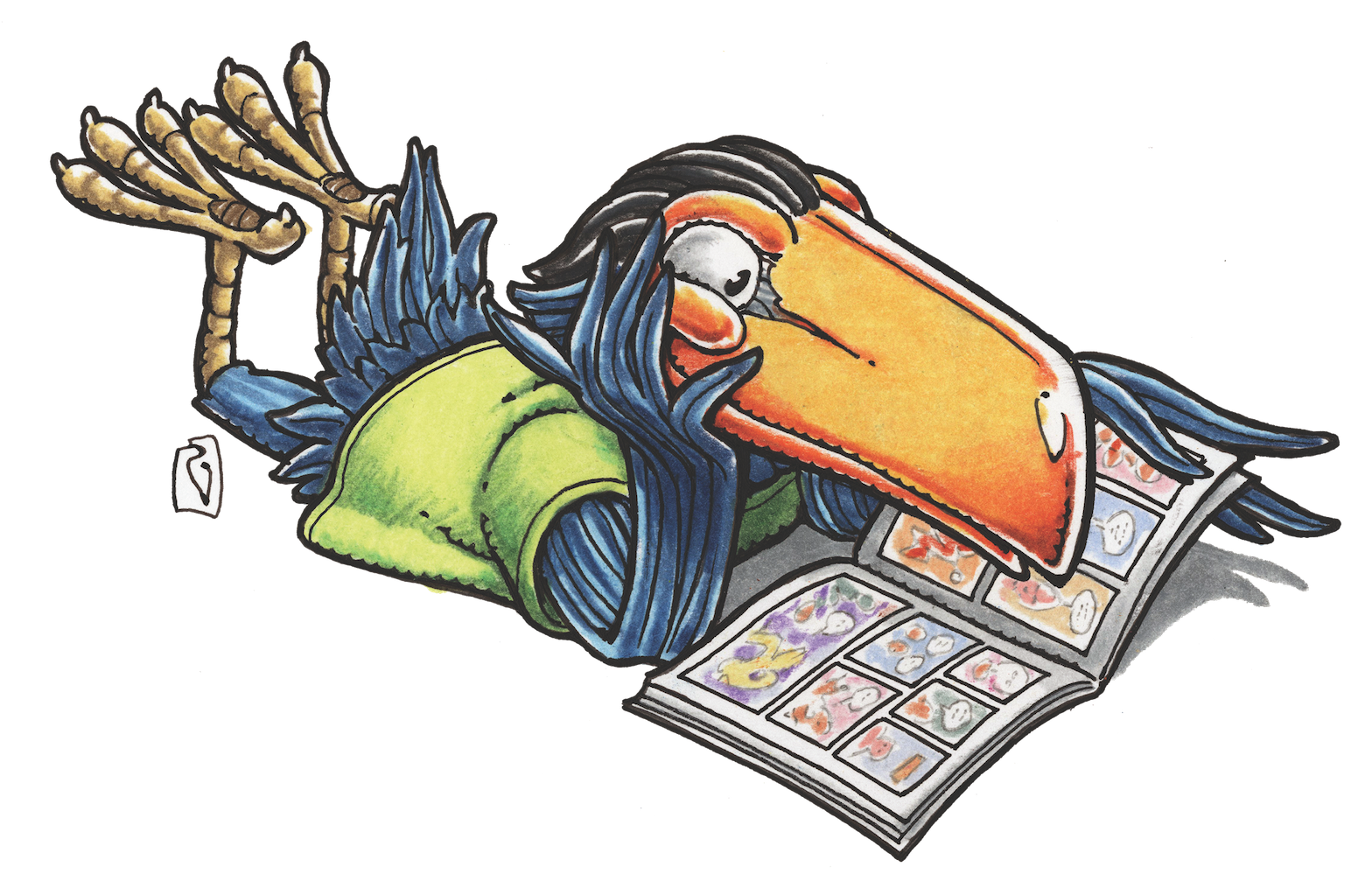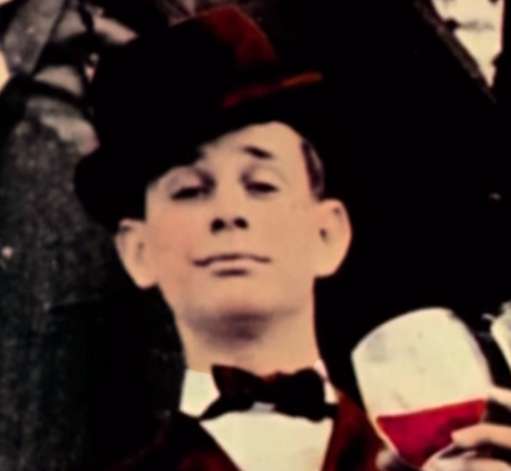JESSE HAMM’S CAROUSEL
Carousel 020: Problem Solving


Most lessons on cartooning are meant to be applied under ideal circumstances, when no special problems block the cartoonist’s goals. But in practice, there are often complications. For example, a script may call for more panels on a page than you’d prefer, or for more dialogue in a panel, leaving you with less space than you need to draw what you want. How do you compensate for such difficulties? Much of your time and energy as a cartoonist will be spent answering that question. To help you out, here are some solutions to many of the more common problems you’ll likely face while drawing a story.
1. When a mass of distracting details appears in a panel, the details can compete with more important elements for the readers’ attention. For instance, a character’s shirt may feature an intricate design which competes with the character’s face, but which—for story reasons—can’t be amended. In such panels, it’s useful to drop a heavy shadow over the details, or block them with a plainer, simpler object. The character may fold her arms over her shirt, or draw up her knees, obscuring her complex shirt design—anything to keep the reader’s attention where it belongs.
2. Some panels have so much dialogue that there’s barely room left for the speaking character, let alone a background. A useful trick in this case is to discard the panel borders and draw only the character’s disembodied head. Isolating the narrator’s head this way keeps the narrative visual while sparing you from struggling to cram everything in.
3. Sometimes a panel’s dialogue requires a figure on the right to speak before a figure on the left speaks. This defies the usual left-to-right reading order, and can cause confusion. If the characters’ positions in the scene are already established, it may be impossible to solve the problem by switching their positions. A handy alternative: Angle the “camera” (the reader’s point-of-view) upward near the rightward character, causing that character to appear higher in the panel than the character on the left. Locating the rightward character’s head near the top of the panel, and the leftward character’s head lower down, will prompt readers to read the rightward character first, avoiding confusion.
4. When you draw a scene in perspective—especially three-point perspective—the shapes near the outer edges of the drawing can sometimes appear warped and slanted. (This is because linear perspective only works within a cone of about 60 degrees wide, projected outward from where the reader is standing—a consideration cartoonists seldom have time to account for.) If you’re on a deadline and find the buildings at the edges of your drawing warping, it would be too much trouble to re-draw the panel. Instead, cover those edges with organic objects (trees, rocks, bystanders), which needn’t conform to linear perspective. Or, if you’re working digitally, enlarge the panel so that the warped shapes fall outside the panel borders, and then delete those shapes.
5. If a humorous panel isn’t as funny as you’d hoped, the problem is often that the panel is too complex or ambiguous. Try simplifying it by zooming in closer on the key elements and cropping out anything superfluous. Adopt a simple, eye-level camera angle for that panel, and make sure the characters’ faces and eyes are clearly visible—not angled away from the reader, or buried in shadow. For jokes to work, it’s often necessary that we understand the characters’ moods, which usually means seeing their eyes.
6. When silhouetting a character or object, you’ll sometimes discover that the silhouette’s contours aren’t distinctive enough to be recognizable. Often this problem can be fixed by including a “false highlight” on some identifying feature within the silhouette. For example, in a scene where Superman and Shazam are silhouetted, you could distinguish them by including a white ‘S’ and a white thunderbolt on their respective chests. Or, similarly-shaped cars can be distinguished by their distinctive grills. It’s a departure from realism, but for clarity’s sake, readers will accept this visual “figure of speech.”
7. If the script calls for a page to include an overwhelming number of panels, look for instances where two panels may be combined into one. Barring that, identify which panels can function as close-ups, and make those your smallest panels. So, suppose Tarzan must yell in Panel 1, grab a vine in Panel 2, and swing on the vine in Panel 3. There’s no reason for those panels to be of equal size. Panel 1 could be a narrow close-up of his face, Panel 2 a small inset of his hand gripping the vine, and Panel 3 could be a bigger panel of him swinging. Furthermore, you might even be able to combine Panels 1 and 2 into a single panel, or Panels 2 and 3.
8.”Dead space” in a panel is a boring area which serves no narrative purpose, but must nevertheless occupy the environment in which the scene occurs. A dinner table, for example, may create a large, boring shape between two characters—wasting valuable “real estate” in the panel—but you can’t get rid of it, because the scene is set in the dining room. To prevent the dead space from dominating your panel, avoid portraying the space from a perpendicular angle (such as a bird’s-eye view, looking down at the table). Instead, align the “camera” with the plane occupied by the dead space, and the space will narrow as the camera approaches its level. Thus, drawing a dining room from slightly above the tabletop will shrink the table’s surface to a sliver, making it occupy less space.
9. Here’s a corollary to the tip above. Sometimes objects in a drawing are grouped so closely together that they are hard to discern, such as when a character is using tools to fix an engine, or arranging place-settings on a table. In these cases, a low angle-of-view confuses the reader by causing objects to overlap and appear to jumble together. Clarity is helped by shifting the angle of view so that it is perpendicular to the plane occupied by the objects — such as a downward shot of the place-settings from above, rather than a low, diagonal view of them from the side. This approach spreads the objects out more, offering more space between them, and more clarity.
10. Some scripts will call for a scene to look “boring.” “Here we meet Darla, a plain-looking woman in a drab, forgettable outfit, working in a dull, nondescript office in Anytown, USA.” Writers may do this to contrast the plainness with the thrills that will arrive later, or maybe to prevent readers from being distracted by ephemera. The trouble is that comics rely on visuals to hold the reader’s attention, so even drabness must enchant the eye. Don’t defy the writer by putting Darla in a sequined gown or giving her office a disco ball, but DO offer readers a visual feast. Darla’s turtleneck and Birkenstocks, her Epson fax machine and faded kitten posters, should promise boredom but instead deliver rich authenticity.
11. Often a comics script will call on the artist to show the same object or environment from the same angle in two or more successive panels. This approach may be necessary for story reasons, but it can quickly bore readers and tempt them to skip ahead. A solution is to zoom in (or out) with each panel. Such changes in proximity can preserve the viewing angle while being dynamic enough to hold the reader’s attention.
12. For story reasons, a character may need to carry a prop that will become relevant later. This can be a hassle because holding the prop may hinder the character from doing a lot of other things you need her to do. Instead, contrive at the outset a way to attach the prop to her clothing and leave her hands free—preferably in an invisible way that will spare you from drawing the prop a thousand times. Maybe she has a hip-pack or backpack into which the prop will disappear, not to be drawn again until it re-emerges 40 pages later. If she carries a weapon, strap it to her back, maybe beneath her hair or a cloak, so you needn’t draw it dangling from her belt in every panel. Similarly, if she wears a hat, maybe include a chin strap, so she won’t have to hang onto it every time there’s an action scene or a strong wind. Don’t allow props to curse you with hassle.
13. Sometimes readers need to know what a character is thinking when she is alone. If there aren’t other characters around in whom she may confide, and if a thought bubble would appear too didactic, you’ll need a visual way to suggest what’s on her mind. This can be achieved by having her look at something relevant to her concerns. Is she fearful of enemies? Maybe she’ll look at the locks on her door. Missing a friend? She could look at something he owned, etc. Her gaze will reveal her concerns.
You will no doubt find your own solutions to problems as you continue to draw your comics, but I hope this list will give you a good head start on avoiding some of the more common difficulties.
See you here next month!